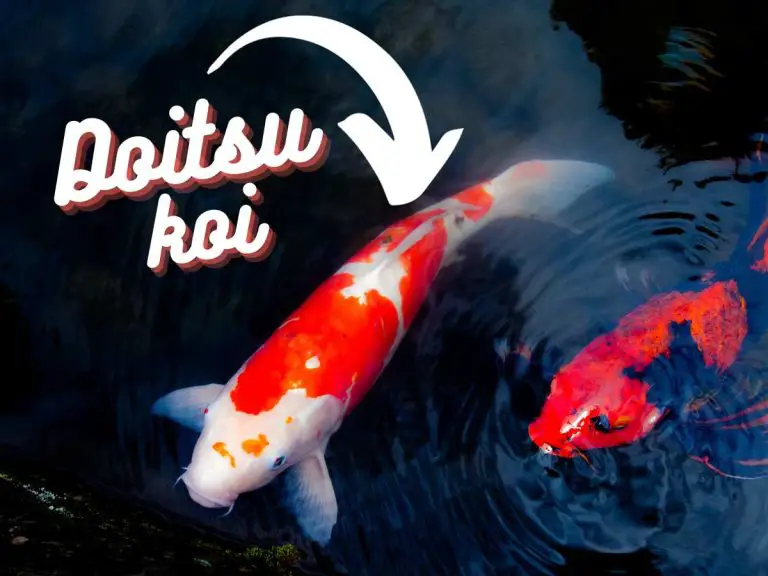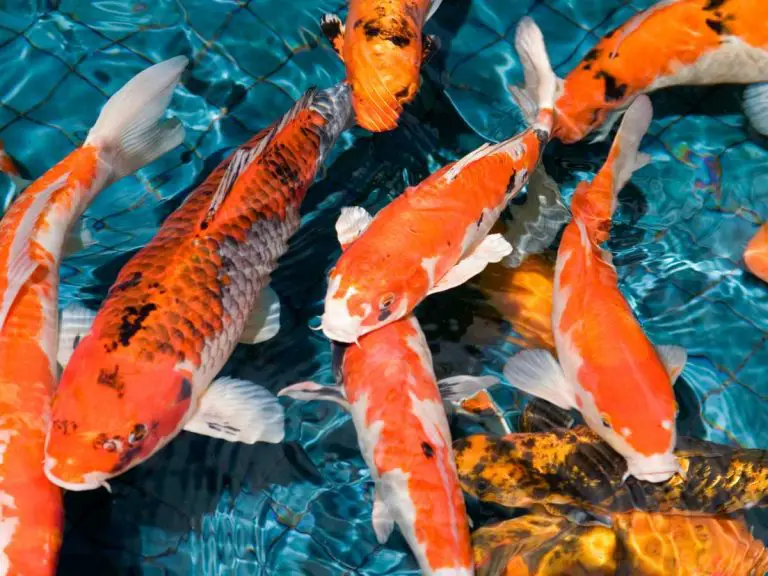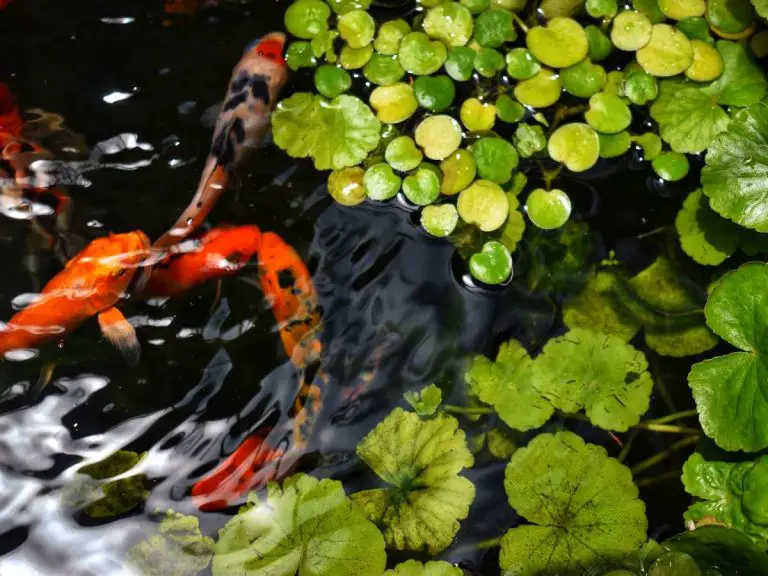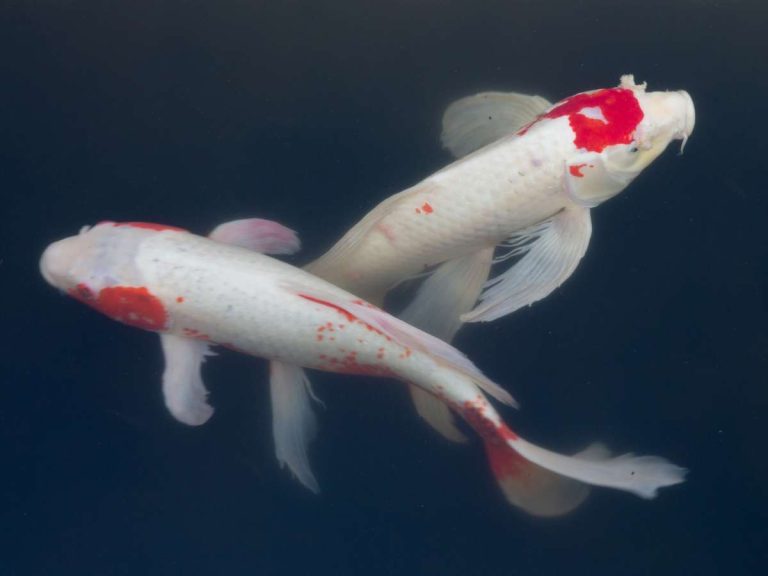Showa Koi Guide: How (And WHY!) To Breed & Raise These Colorful Fish
The world of koi fish is vast and varied, with each variety bringing its own unique charm to the table. Among them, the Showa koi stands out with its mesmerizing interplay of colors and patterns.
With their distinctive black base adorned with vibrant red and white markings, showa koi are a sight to behold in any pond. But there’s more to Showa koi than meets the eye. From understanding their unique characteristics to mastering the art of their care, breeding, and selection, there’s a wealth of knowledge awaiting both novice and seasoned koi enthusiasts.
Whether you’re looking to add these beauties to your pond, ensure their optimal health, or delve into the intricacies of breeding for even brighter color, this article have you covered. Let’s jump in.
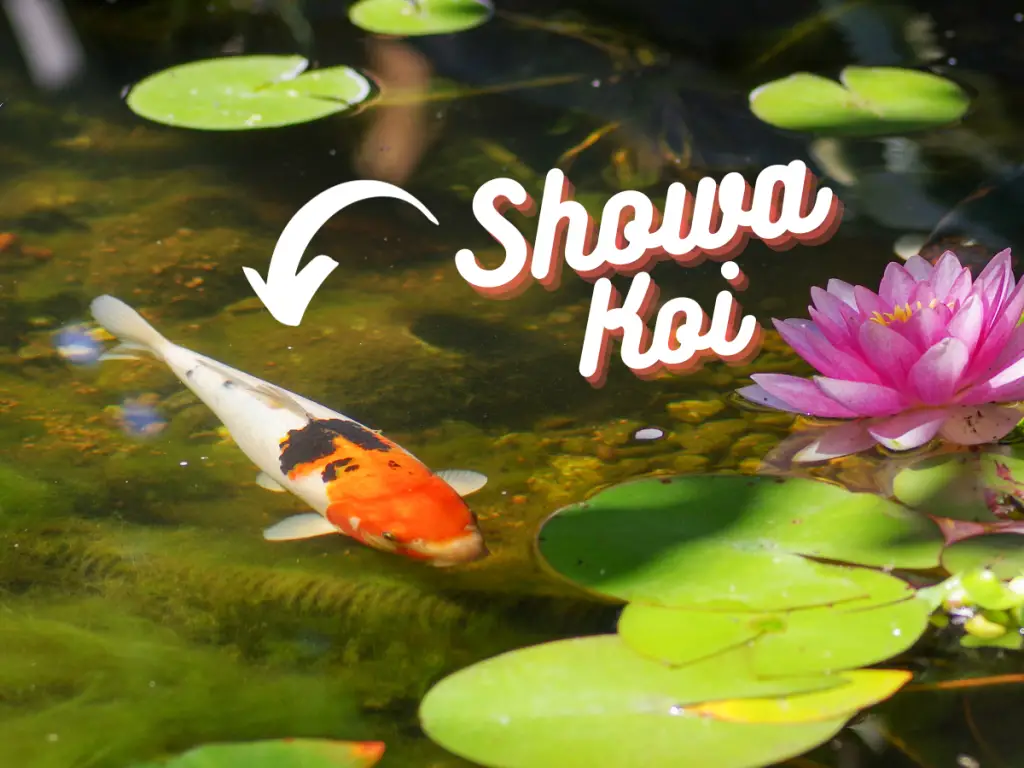
Showa Koi At A Glance
| Aspect | Details |
|---|---|
| Color Base | Black |
| Markings | Vibrant red and white markings |
| Unique Feature | No two Showa koi have the exact same pattern |
| Ideal Body Shape | Long, sleek, smooth, and rounded |
| Average Size | 2 to 3 feet (can vary based on conditions) |
| Water Quality | Regular testing for pH, ammonia, nitrite, and nitrate levels |
| Diet | Combination of pellets, flakes, and live food |
| Feeding Frequency | Several small meals throughout the day |
| Breeding Techniques | Natural breeding and artificial spawning |
| Pond Recommendations | Minimum 1000 gallons, depth of at least three feet |
| Key to Selection | Vibrant colors, well-defined patterns, healthy body shape, purchase from reputable breeders |
Characteristics of Showa Koi
The most striking characteristic of Showa koi is their unique color patterns. These magnificent fish have a black base with vibrant red and white markings that create a stunning contrast in the water.
Plus, with Showa koi, no two fish are exactly alike. Each individual has its own distinct pattern and arrangement of colors. Some may have more black, while others may have more red or white. It’s this endless variety that makes Showa koi so captivating and beautiful.
The ideal body shape for these fish is long and sleek, with a smooth and rounded appearance. They should have well-developed pectoral fins and a strong, muscular body.
Finally, Iin terms of size, Showa koi can grow quite large if provided with the right conditions. On average, they can reach a length of 2 to 3 feet, though some can even exceed that. It’s important to keep in mind that their growth rate can be influenced by factors such as water temperature and quality.
History and Development of Showa Koi
The Showa Koi, also known as Showa Sanshoku, is a captivating variety of the Nishikigoi (colored carp). Its origins trace back to the early 20th century in Japan.
The name “Showa” is derived from the Showa era in Japan, during which this koi variety was first developed. Introduced in 1927, the Showa Koi is a result of crossbreeding the Sanke Koi and the Kohaku Koi.
Initially, the Showa had a predominantly black appearance, but with selective breeding over the years, the vibrant red and white patterns became more pronounced, leading to the stunning tri-colored variety we recognize today.
The evolution of the Showa Koi’s coloration and pattern is a testament to the dedication and expertise of Japanese breeders. Today, Showa Koi are celebrated worldwide for their unique beauty and are a prized possession in many koi collections.
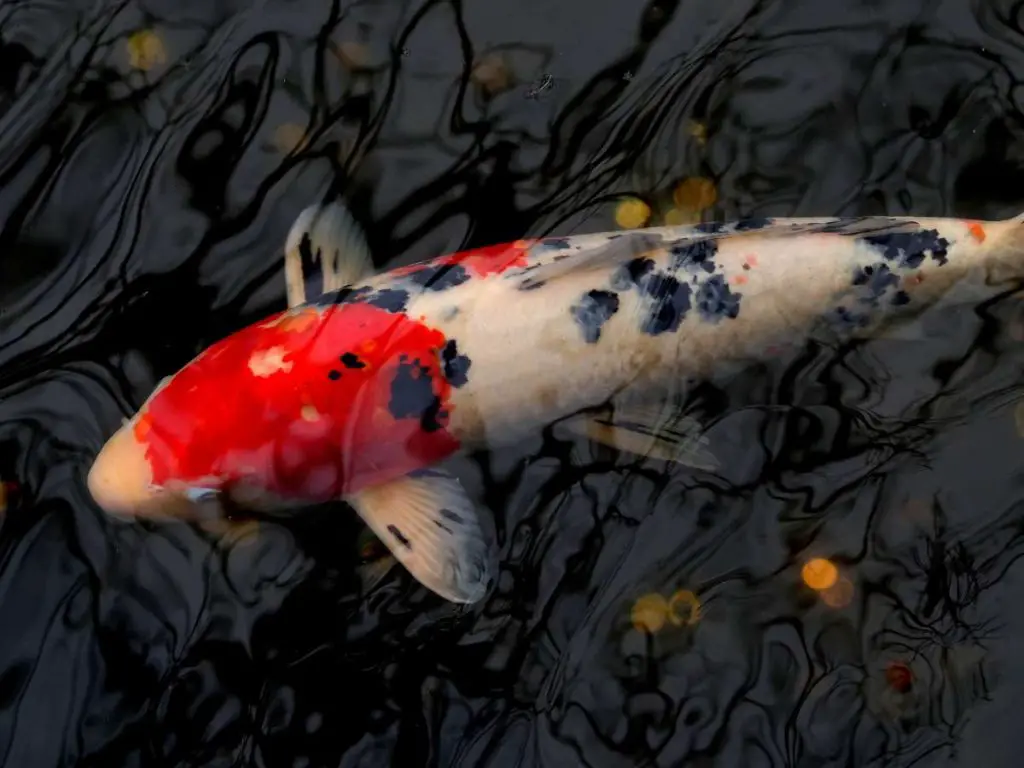
Showa Koi Care
When it comes to taking care of Showa koi, one of the most important aspects is maintaining proper water quality. These fish are highly sensitive to their environment, so it’s crucial to ensure that their water conditions are optimal.
To keep your Showa koi healthy and happy, you’ll need to regularly test the water for pH levels, ammonia, nitrite, and nitrate levels. This will help you monitor the water quality and take appropriate action if any imbalances are detected.
In addition to regular testing, investing in a good filtration system is essential. A high-quality filter will help remove impurities and keep the water clean and clear, creating a suitable environment for your Showa koi to thrive in.
When it comes to feeding your Showa koi, it’s important to provide them with a balanced and nutritious diet. These fish have specific dietary requirements that need to be met in order for them to grow and develop properly.
There are various types of food available for Showa koi, including pellets, flakes, and live food. It’s usually best to offer a combination of these foods to ensure a well-rounded diet for your fish. You can even make your own koi food if you’re up for the challenge.
Feeding your Showa koi should be done in moderation. Overfeeding can lead to health problems and poor water quality. A general guideline is to feed them several small meals throughout the day rather than one large meal. This will help prevent overeating and improve digestion.
Feeding Schedule and Portion Control
Establishing a regular feeding schedule is important to maintain the health and growth of your Showa koi. Younger koi should be fed multiple times a day, while older koi can be fed once or twice daily. It’s best to split their daily intake into smaller meals to prevent overfeeding and avoid any waste that can negatively impact water quality.
When determining the portion size, be mindful of the amount your koi can consume in just a few minutes. Overfeeding can lead to health issues like obesity, bloating, and poor water quality. Always remember that it’s better to slightly underfeed than overfeed your koi.
If you have multiple koi in the same pond (say some tancho koi, for example, or a lovely Utsurimonoi), ensure that each fish gets an equal chance to eat by spreading the food across different areas. This will help prevent dominant fish from hogging all the food, ensuring that all your koi receive their fair share.
Monitor your koi’s feeding behavior and adjust the portion size accordingly. If you notice that they are consistently not finishing their meals, you may need to reduce the amount of food you’re offering. On the other hand, if they devour their food quickly and are still hungry, you can slightly increase the portion size.
Remember, feeding your Showa koi is not just about providing them with sustenance; it’s also an opportunity to observe and connect with these beautiful creatures. Take a moment to enjoy their colors and patterns as they gracefully swim and feed in your pond.
Showa Koi Breeding Tips

Choosing the right breeding pairs is crucial for producing high-quality Showa offspring – and all that vibrant color you want.
Ultimately, you want to select individuals that exhibit desirable traits such as bright colors, well-defined patterns, and healthy body shapes. In other words, look for Showa koi with strong genetics and characteristics that you hope to pass on to their offspring.
It’s also important to consider the potential genetic combinations between the male and female fish. Assess whether their colors and patterns complement each other or if there is a chance of producing undesirable patterns or colors.
Remember, the goal is to produce offspring with beautiful, eye-catching patterns that stand out in your pond.
Two breeding techniques
There are two primary breeding techniques for Showa koi: natural breeding and artificial spawning.
In natural breeding, you simply provide the right environment for the fish to breed naturally. This technique mimics their natural ecosystem, allowing them to go through the mating process on their own. It requires a well-maintained pond with proper water conditions and enough space for the fish to spawn comfortably. Natural breeding can be a more hands-off approach, but it still requires careful monitoring and observation.
On the other hand, artificial spawning involves manually collecting eggs from female fish and fertilizing them with milt from male fish. This technique gives you more control over the breeding process and allows you to selectively breed fish with specific traits. It is a more involved process that requires precise timing and proper handling of the eggs and milt. Artificial spawning might be the preferred method for breeders looking to create offspring with specific patterns or colors.
Spawning process and care for fry
During the spawning process, it’s important to maintain optimal water conditions and temperature. Monitor the water parameters closely, ensuring they are within the ideal range for breeding. Additionally, make sure there are suitable hiding places, such as spawning mats or plants, where the fish can deposit their eggs.
After the eggs are laid, it’s crucial to remove the adult fish from the breeding tank to prevent them from eating their own eggs. The eggs will hatch in a few days, and the fry will require special care during this delicate stage. Regular water changes, proper nutrition, and careful monitoring of water quality are essential to ensure the survival and healthy growth of the baby Showa koi.
Evaluating the Quality of Showa Koi
When selecting Showa Koi fish (or buying any koi online, for that matter), it’s important to evaluate their quality before making a purchase. There are a few key things to look for when choosing Showa Koi that will help ensure you’re getting healthy and high-quality fish.
First and foremost, you want to carefully examine the color and pattern of the Showa Koi. Look for strong, vibrant colors that stand out. The black base should be rich and deep, with no dull or faded patches. The red and white markings should be well-defined and evenly distributed.
Remember: Avoid choosing fish with weak or uneven colors, as this may indicate a lack of health or breeding issues.
Next, take a close look at the body shape of the Showa Koi. The ideal body shape is streamlined with a slightly rounded belly. Avoid fish that appear too skinny or too fat.
Additionally, check for any abnormalities or deformities in the body structure, such as bent spines or uneven scales. These can be signs of genetic issues or poor breeding.
Purchasing from Reputable Breeders or Dealers
When it comes to buying Showa Koi, it’s always best to purchase from reputable breeders or dealers. This ensures that you’re getting healthy fish that have been properly cared for and bred. Reputable breeders are knowledgeable about Koi and can provide valuable advice and assistance when selecting your fish.
Look for breeders who have a good track record and positive reviews from other buyers. They should have clean and well-managed facilities, with proper filtration systems and regular water testing. Ask for recommendations from other Koi enthusiasts or join online forums where experienced hobbyists share their experiences and recommendations.
Setting Up a Showa Koi Pond
If you’re thinking about adding a beautiful Showa koi to your pond, it’s essential to create the perfect environment for them to thrive. Setting up a Showa koi pond involves careful consideration of size, depth, and design elements.
Pond size and depth recommendations
The size and depth of your pond play a crucial role in providing ample space for your Showa koi to swim and grow.0
As a general rule, you should aim for a pond that can accommodate the adult size of your fish. Showa koi can reach lengths of up to 30 inches, so make sure your pond is at least 1000 gallons or more.
Remember, the more space your koi have, the happier they will be!
In terms of depth, aim for a minimum of three feet in areas where your koi can’t easily touch the bottom. This provides them with enough space to swim comfortably and escape extreme temperatures. Additionally, consider adding shallow areas or ledges where your koi can bask in the sun and rest. These areas should be around 18 inches deep to allow your koi to enjoy some R&R without going too deep.
Pond design and features
When designing your Showa koi pond, keep in mind that filtration systems and equipment are crucial for maintaining optimal water quality. A good filtration system helps remove debris, excess nutrients, and harmful substances from the water, creating a healthy environment for your fish. Look for high-quality biological and mechanical filters that can handle the volume of water in your pond.
Besides filtration systems, consider adding features like waterfalls, fountains, or aerators. These not only enhance the aesthetics of your pond but also provide essential aeration and circulation. Proper aeration ensures that oxygen levels remain adequate, which is vital for the health and well-being of your Showa koi.
Final Thoughts
Selecting high-quality Showa Koi fish is essential for creating a successful Koi pond. By evaluating the color, pattern, and body shape of the fish and purchasing from reputable breeders or dealers, you can ensure that you’re starting with healthy and vibrant Koi.
Remember to take your time and carefully choose your fish – a little extra effort in the beginning will pay off in the long run when you have a pond filled with beautiful and thriving Showa Koi.
Key Takeaways
- Showa koi have a black base with red and white markings, and they come in various patterns.
- Proper water quality management is crucial for the health of your Showa koi.
- Feeding Showa koi the right food and sticking to a schedule is important for their growth and well-being.
- If you’re interested in breeding Showa koi, carefully select breeding pairs and consider different breeding techniques.
- When setting up a pond, make sure it’s the right size, depth, and has the necessary equipment for filtration.
- When selecting Showa koi fish, evaluate their quality and purchase from reputable breeders or dealers.
Remember, creating a suitable environment for your Showa koi involves not just providing proper care but also understanding their unique needs. By following the advice in this guide, you can ensure that you’re giving your Showa koi the best possible care.
Related Questions
Can Showa koi be kept with other types of fish in the same pond?
Yes, Showa koi can be kept with other types of fish in the same pond as long as they are compatible in terms of size and temperament. It’s important to consider the needs and requirements of all the fish species when planning the pond environment to ensure a harmonious coexistence.
How long do Showa koi live?
Showa koi have a lifespan of around 25-35 years, but with proper care and a healthy environment, they can live even longer. Consistent monitoring of water quality, regular feeding, and providing a suitable habitat are key factors in ensuring the longevity of Showa koi.

